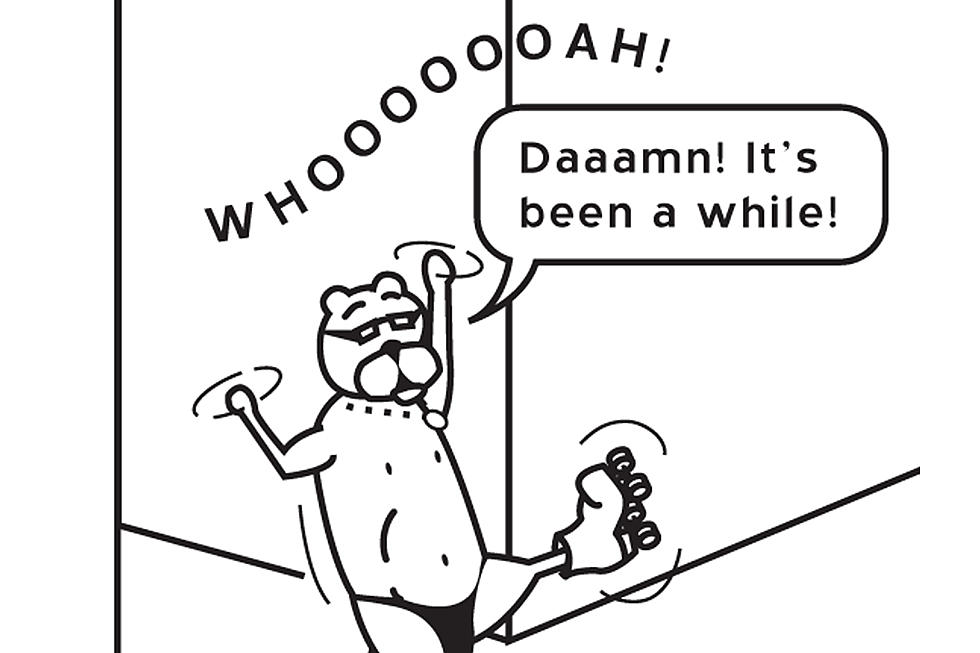
Ask Chris #283: The Weirdest Part Of ‘Achewood’
Q: What's the weirdest thing to happen in Achewood? -- @Koltreg
A: Okay, this is a tough one. As I've mentioned more than a few times in this very column, Chris Onstad's Achewood --- which recently resurrected itself with a series of pretty regular weekly updates --- is one of my favorite comics of all time, and part of the reason for that is that pretty much everything that happens in it is really, really weird, to the point where even figuring out a baseline of what constitutes "weird even for Achewood" is darn near impossible.
Take, for instance, The Great Outdoor Fight, arguably the high point of the strip. That's a story that involves two cats heading to some lawless farm outside of Bakersfield to battle 3,000 men in a no-holds-barred free-for-all that lasts for three days, and involves rigid rules about army leaders, turkey feasts, and unseen but murderous organizers who threaten to mow down the competitors with Jeeps, all of which somehow gets started when a meth-addicted squirrel tries to borrow $6,000,000 to start a business building genitals for cars. And honestly, that's probably the most straightforward story of the strip's entire run.
What I'm getting at here is that when it comes to figuring out the weirdest pieces of Achewood, the problem isn't digging through the archives to find something strange, it's narrowing things down.
The obvious answer would probably be something involving Cartilage Head, the silent, endlessly weeping performance artist who disturbs audiences by performing on the musical saw and snapping his own boneless cranium out of place, and seems to exist for the sole purpose of shaming those who see his act as cowards who would desert a dying man. He's certainly the creepiest part of the strip, and he's been at the center of some pretty strange storylines --- including one that involved a battle for control of the Williams-Sonoma kitchenware corporation that played out with two men in elephant costumes writing lesbian erotica in front of a live audience.
When you consider the rest of the strip, though, even Cartilage Head doesn't really stick out all that far. I mean, there are stories in this comic where people travel back in time and introduce 17th Century Wales to nachos, and where one character finds himself trapped in a text-based adventure game alongside North Korean dictator Kim Jong-Il. Compared to those, even a tear-stained skeleton who communicates solely through elaborately calligraphied note cards is just another day at the office.
If you really want to find something that sticks out as the weirdest piece of Achewood, then you have to look for something that goes a step further. It can't just be a weird situation that plays out for the characters, and it can't even be something that brings in the supernatural, or even something that plays with the format. It has to be something that goes far enough that it feels like it's actually breaking the rules and doing something completely different.
And for that, it pretty much has to be "Magical Realism."
"Magical Realism" certainly isn't the first time that Achewood got weird. It ran in late 2006, and since that was the same year as "The Great Outdoor Fight" and the famously amazing story about Philippe trying to find a couch that ends when Ray buys Airwolf, it's safe to say that things were already pretty strange. Heck, at this point, Roast Beef had even died twice and met his future wife, who died in a shipwreck in the 1600s, in Heaven.
Even the idea of "Mexican Magical Realism" items --- a recurring gag about products imported from Mexico that brought an added layer of surrealism to the comic's sitcom setups --- had been introduced in a previous story about a camera that took pictures of your self-image rather than how you actually look. This story, though, puts it at the center of the spotlight, and it starts in a very Achewood sort of way.
See, there's always a setup that leads to the weird stuff --- even when the Magical Realism Camera was introduced, it was just the first step towards getting to another story --- and here, it revolves around Ray Smuckles and his chief rival, Bensington Butters. Onstad never really goes into the details, but both men (uh, cats, but you know what I mean) are record moguls who are part of an organization called The Brothers In The Syndicate, and they hate each other behind a façade of professional friendliness.
At the start of this story, Ray discovers that for all of his nouveau-riche pretensions, Butters is actually the kind of low-class Floridian who carries a bottle of Hunt's Ketchup with him wherever he goes. When the two of them end up sharing a helicopter together to a meeting/group vacation of the Brothers in the Syndicate, it seems like it might be the setup for a buddy comedy, or a conflict between the two of them.
But then their luchador-masked helicopter causes their legs to grow fifty feet, puts them to sleep, and begins to walk south.
This is where things start to get weird, and like I said, it's where Onstad starts to break the rules of the strip. I think it's fair to say that Achewood is primarily dialogue-driven, to the point where I have multiple friends whose speech patterns have been altered by reading it, in the same way that Homestar Runner became a certain sort of conversational shibboleth back in the aughts. But here, the strip goes into a few silent pages, completely devoid of dialogue.
The art style changes, too --- there's a page of the helicopter, now using Butters' and Ray's legs as its own, walking in front of backgrounds made of blurry photographs. And in fact, everything is blurry, drifting out of focus in contrast to the sharp, uniform lines that usually make up Achewood's art. And that's a motif that persists once the arc's new character shows up:
This is Lonis Edison, presumable brother to Tom. He's never in focus, and glows a little bit, and he comes from the same sort of studiously bizarre, weird-for-weirdness-sake school of character design that gives us Cartilage Head. But while Cartilage Head's weirdness comes from his silence, Lonis ends up being a chatterbox, never managing to shut up about his impractically surreal inventions.
The helicopter, however, is never addressed or explained.
Eventually, in true Willy Wonka fashion, Butters wanders off the path of the tour and ends up taking a hit of ketchup that reveals the exact date, time and method of his own death, thanks to a peculiar arrangement of stones. Everything works out all right in the end, though, and Ray makes it back to Achewood just in time to get roped into an email scam that turns out to be something completely diferent.
And that, for my money, is the weirdest that Achewood ever got. It might not go to the extremes that you get from later stories --- you would not have a hard time convincing me that the one with the text-based adventure was, in fact, a whole lot stranger in virtually every way --- but I don't think we would've gotten to those stories without this one. This takes the idea of Magical Realism and revives it from a one-off joke to a driving force of the strip, and it does it by experimenting with the format and getting away from what readers expected.
Ask Chris art by Erica Henderson. If you’ve got a question you’d like to see Chris tackle in a future column, just send it to @theisb on Twitter with the hashtag #AskChris.
More From ComicsAlliance









